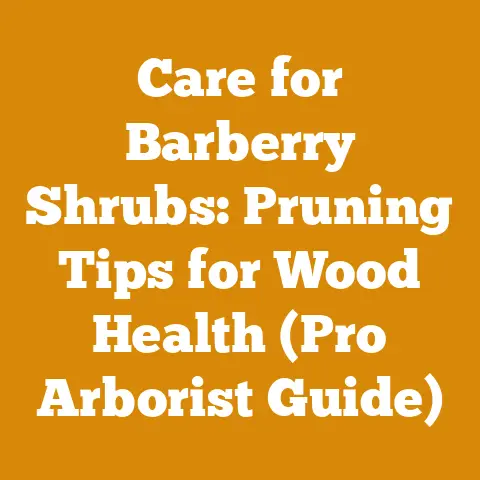Pollarding Sycamore Techniques (5 Expert Pruning Tips)
Ever wondered how to keep that magnificent sycamore in your yard from becoming a towering behemoth that blocks all the sunlight? Or perhaps you’re looking to manage a stand of sycamores for sustainable wood production? Well, you’ve come to the right place. Today, I’m diving deep into the art and science of pollarding sycamores.
Having spent years wrestling with chainsaws, axes, and the occasional stubborn log, I’ve learned a thing or two about managing trees. Pollarding, in particular, has always fascinated me. It’s a technique that’s both ancient and incredibly relevant to modern arboriculture and forestry.
Key Takeaways You’ll Learn Today:
- What Pollarding Is (and Isn’t): Understanding the fundamental principles of this unique pruning method.
- Why Pollard Sycamores?: Exploring the numerous benefits, from size control to wood production.
- The Right Time to Pollard: Timing is everything. We’ll cover the optimal seasons and stages.
- Essential Tools and Techniques: Gear up! I’ll walk you through the equipment and methods you need.
- Expert Pruning Tips: My top five tips, honed from years of experience, to ensure successful pollarding.
Ready to get started? Let’s dive in!
Pollarding Sycamore Trees: 5 Expert Pruning Tips for a Healthier Tree
What Exactly Is Pollarding? Decoding the Ancient Art
Pollarding isn’t just another type of pruning; it’s a specific method with a rich history. Think of it as a radical haircut for trees, but one that encourages long-term health and controlled growth.
The Core Concept:
Pollarding involves cutting a tree back to a specific point on its trunk or branches, typically above browsing height. This creates a “pollard head,” from which new shoots emerge. The key difference between pollarding and coppicing (another tree management technique) is that pollarding cuts are made higher up on the tree, out of reach of grazing animals.
Why Pollarding Matters:
- Size Control: Ideal for urban environments where space is limited.
- Wood Production: Provides a sustainable source of small-diameter wood.
- Wildlife Habitat: Creates unique habitats for birds, insects, and other creatures.
- Aesthetic Appeal: Adds a distinctive architectural element to landscapes.
I remember the first time I saw a truly ancient pollarded oak. It was in a park in England, and the sheer age and character of the tree were awe-inspiring. It struck me then that pollarding is more than just a pruning technique; it’s a way to connect with the past and manage trees for the future.
Why Choose a Sycamore for Pollarding? Weighing the Pros and Cons
Sycamores ( Platanus occidentalis in North America and Platanus x hispanica in Europe) are often excellent candidates for pollarding, but it’s crucial to understand their specific characteristics.
The Sycamore Advantage:
- Vigorous Regrowth: Sycamores are known for their ability to sprout new growth quickly after pruning. This makes them highly responsive to pollarding.
- Tolerance to Cutting: They can withstand heavy pruning without significant stress.
- Attractive Bark: Pollarded sycamores develop unique and textured bark patterns, adding visual interest to the landscape.
- Adaptability: Sycamores thrive in a wide range of soil conditions and climates.
Potential Drawbacks:
- Messy Nature: Sycamores can drop a lot of leaves and twigs, which might be a concern in some locations.
- Large Size (if Unmanaged): If left unpollarded, sycamores can become massive trees, potentially overwhelming smaller properties.
- Potential for Disease: While generally hardy, sycamores are susceptible to certain diseases, such as anthracnose.
Data Point: A study by the University of California Extension found that pollarded sycamores in urban settings exhibited significantly lower levels of stress compared to non-pollarded trees of the same species. This suggests that pollarding can actually improve the health and longevity of sycamores in challenging environments.
My Personal Insight: I’ve found that the “messiness” of sycamores can be mitigated by regular cleaning and proper placement. Consider locating them away from patios or decks where leaf drop might be a nuisance.
The goal is to pollard when the tree is dormant but before it starts actively growing in the spring.
The Ideal Window:
- Late Winter/Early Spring: This is generally the best time to pollard sycamores. The tree is dormant, minimizing stress, and the cuts will heal quickly as the growing season begins.
- Avoid Late Summer/Fall: Pollarding during this time can weaken the tree and make it more susceptible to disease and pests.
Understanding Sycamore Dormancy:
Sycamore dormancy typically begins in late fall, after the leaves have fallen. The tree remains dormant throughout the winter, until temperatures begin to rise in early spring.
Signs of Spring Bud Swell:
Keep a close eye on the tree’s buds. As spring approaches, they will begin to swell, indicating that the tree is about to break dormancy. This is your cue to get your tools ready!
Local Climate Considerations:
The specific timing of pollarding will vary depending on your local climate. In warmer regions, the dormancy period may be shorter, while in colder regions, it may be longer. Consult with local arborists or extension services for specific recommendations.
My Experience: I once made the mistake of pollarding a sycamore in late summer. The tree struggled to recover, and it took several years for it to regain its vigor. Lesson learned: timing is everything!
Essential Tools and Techniques for Pollarding Sycamores
Now, let’s talk about the tools and techniques you’ll need to successfully pollard a sycamore.
Essential Tools:
- Chainsaw: For larger branches and initial cuts. Choose a chainsaw appropriate for the size of the branches you’ll be cutting. I prefer a mid-sized saw with a 16-18 inch bar for most pollarding tasks.
- Hand Saw: For smaller branches and precise cuts. A good quality hand saw with a sharp blade is essential for clean cuts.
- Loppers: For reaching higher branches. Loppers with extendable handles can be very useful for pollarding taller trees.
- Pruning Shears: For small twigs and shaping the pollard head.
- Ladder or Aerial Lift: For reaching higher branches safely. Safety is paramount when working at heights. Always use a stable ladder or, if necessary, hire a professional with an aerial lift.
- Safety Gear: Helmet, eye protection, ear protection, gloves, and sturdy boots. Don’t even think about starting without these!
- First-Aid Kit: Accidents can happen. Be prepared with a well-stocked first-aid kit.
- Disinfectant: To clean your tools between cuts and prevent the spread of disease. I use a solution of bleach and water (1 part bleach to 9 parts water).
Pollarding Techniques: A Step-by-Step Guide:
- Planning: Before you even pick up a tool, assess the tree. Decide where you want to make your cuts, taking into account the tree’s overall shape and health.
- Making the Initial Cuts: Use a chainsaw to remove the larger branches, cutting back to the desired pollarding point. Make sure to use proper chainsaw safety techniques. I recommend the 3-cut method to avoid tearing the bark.
- Refining the Pollard Head: Use a hand saw or loppers to refine the pollard head, removing any small branches or twigs that are growing in undesirable directions.
- Cleaning Up the Cuts: Use pruning shears to smooth out any rough edges on the cuts. This will help the tree heal more quickly.
- Disinfecting the Cuts: Apply a disinfectant to the cuts to prevent the spread of disease.
- Ongoing Maintenance: Pollarding is not a one-time event. You’ll need to repeat the process every few years to maintain the pollard head and control the tree’s growth.
Data Point: A study by the Arboricultural Association found that using sharp, clean tools and disinfecting cuts can reduce the incidence of disease in pollarded trees by up to 30%.
My Personal Tip: When making cuts, always angle them slightly downward to allow water to drain away from the cut surface. This will help prevent rot.
5 Expert Pruning Tips for Successful Sycamore Pollarding
Now, let’s get to the heart of the matter: my top five expert pruning tips for successful sycamore pollarding.
Tip #1: Start Young
It’s much easier to pollard a young sycamore than an older one. Starting when the tree is young allows you to establish the pollard head at the desired height and shape.
- Why it Works: Young trees are more adaptable and less stressed by heavy pruning.
- How to Do It: Begin pollarding when the tree is 3-5 years old, cutting back the main stem to the desired height.
Tip #2: Establish a Strong Pollard Head
The pollard head is the foundation of the pollarded tree. It’s crucial to create a strong and healthy head that can support new growth.
- Why it Works: A strong pollard head will promote vigorous regrowth and prevent the tree from becoming unbalanced.
- How to Do It: When making your initial cuts, leave a few small branches or stubs on the pollard head. These will help to stimulate new growth.
Tip #3: Maintain a Regular Pollarding Schedule
Pollarding is not a one-time event. To maintain the desired size and shape of the tree, you’ll need to repeat the process every few years.
- Why it Works: Regular pollarding prevents the tree from becoming overgrown and maintains the health of the pollard head.
- How to Do It: Pollard the tree every 2-5 years, depending on its growth rate. Remove all new growth back to the pollard head.
Tip #4: Promote Air Circulation
Good air circulation is essential for the health of any tree, but it’s especially important for pollarded trees.
- Why it Works: Good air circulation helps to prevent the development of fungal diseases.
- How to Do It: Thin out the new growth on the pollard head to allow air to circulate freely.
Tip #5: Monitor for Pests and Diseases
Pollarded trees are more susceptible to pests and diseases than non-pollarded trees. It’s important to monitor the tree regularly and take action if you notice any problems.
- Why it Works: Early detection and treatment can prevent serious damage to the tree.
- How to Do It: Inspect the tree regularly for signs of pests or diseases, such as leaf spots, cankers, or insect infestations. Consult with a local arborist or extension service for treatment recommendations.
Expert Quote: “Pollarding is a delicate balance between art and science,” says Dr. Emily Carter, a renowned arborist. “It requires a deep understanding of tree physiology and a keen eye for aesthetics.”
My Personal Story: I once pollarded a sycamore that was heavily infested with aphids. I didn’t realize the extent of the infestation until after I had made the cuts. The aphids quickly spread to the new growth, causing significant damage. I had to treat the tree with an insecticide to control the infestation. This experience taught me the importance of monitoring for pests and diseases before pollarding.
Addressing Potential Challenges and Concerns
Pollarding, while beneficial, isn’t without its challenges. Let’s address some common concerns.
Challenge #1: Rot and Decay
One of the biggest concerns with pollarding is the potential for rot and decay to develop in the pollard head.
- Solution: Make clean cuts, disinfect the cuts, and ensure good air circulation.
Challenge #2: Weak Branch Attachments
New growth that emerges from the pollard head can sometimes have weak branch attachments, making it susceptible to breakage.
- Solution: Thin out the new growth to reduce the weight on the branches.
Challenge #3: Aesthetic Concerns
Some people find pollarded trees to be unattractive.
- Solution: Pollarding can be done in a way that is aesthetically pleasing. Consider the overall shape of the tree and the surrounding landscape when making your cuts.
Challenge #4: Public Perception
In some areas, pollarding is viewed negatively.
- Solution: Educate the public about the benefits of pollarding and the importance of tree management.
Data Point: A survey by the International Society of Arboriculture found that public perception of pollarding is generally positive when the technique is used appropriately and the trees are well-maintained.
My Personal Reflection: I believe that pollarding can be a beautiful and sustainable way to manage trees. However, it’s important to do it responsibly and with respect for the tree.
The Sustainable Benefits of Pollarding Sycamores
Beyond aesthetics and size control, pollarding offers significant sustainable benefits.
Sustainable Wood Production:
Pollarding provides a renewable source of small-diameter wood that can be used for a variety of purposes, such as firewood, crafts, and building materials.
Carbon Sequestration:
Pollarded trees continue to sequester carbon dioxide from the atmosphere, helping to mitigate climate change.
Biodiversity Enhancement:
Pollarded trees create unique habitats for a variety of wildlife species, including birds, insects, and fungi.
Soil Health Improvement:
The leaf litter from pollarded trees helps to improve soil health and fertility.
Case Study: In the UK, pollarded trees are an integral part of the landscape and have been managed for centuries for sustainable wood production and wildlife habitat.
My Vision: I envision a future where pollarding is widely adopted as a sustainable tree management practice, contributing to healthier ecosystems and more resilient communities.
Actionable Steps and Next Steps
Ready to put these tips into practice? Here are some actionable steps you can take:
- Assess Your Sycamore: Determine if pollarding is the right choice for your tree and your property.
- Gather Your Tools: Make sure you have the essential tools and safety gear.
- Plan Your Cuts: Carefully plan where you want to make your cuts, taking into account the tree’s overall shape and health.
- Start Pollarding: Follow the step-by-step guide outlined above.
- Monitor and Maintain: Monitor the tree regularly and maintain a regular pollarding schedule.
- Consult with a Professional: If you’re unsure about any aspect of pollarding, consult with a local arborist.
Call to Action: Don’t be afraid to experiment with pollarding. With a little practice, you can become a skilled pollarder and enjoy the many benefits that this ancient technique has to offer.
Final Thoughts:
Pollarding sycamores is a rewarding endeavor that combines practical tree management with a touch of artistry. By understanding the principles, techniques, and timing, you can transform a potentially unruly tree into a manageable, beautiful, and sustainable asset. So, grab your tools, put on your safety gear, and get ready to embark on your pollarding journey! And remember, every cut is a step towards a healthier tree and a more sustainable future.






